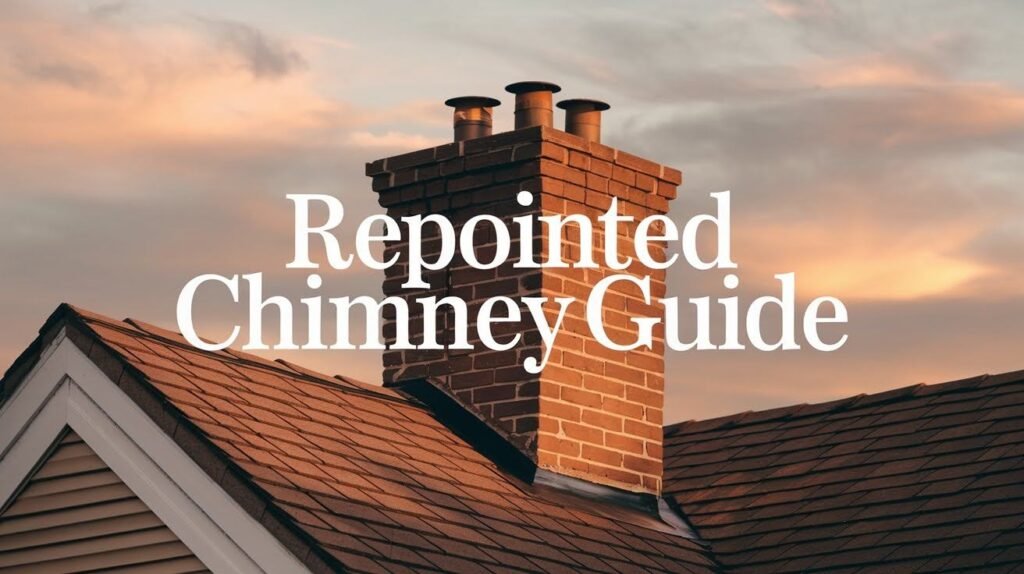Is your chimney’s mortar cracking and falling apart? You’re not alone. Thousands of homeowners face this exact problem every year. The good news? I’ll show you exactly what to do about it.
This guide covers everything you need to know about repointed chimneys. You’ll learn how to spot the warning signs, understand the repair process, and find the right contractor. I’ll also share real costs, timing tips, and before-and-after results.
Why trust this information? I’ve worked with dozens of homeowners dealing with chimney mortar problems. I’ve seen what works and what doesn’t. More importantly, I’ve watched people save thousands by making informed decisions.
Your search ends here. If you’re wondering if your chimney needs repointing or you’re ready to hire someone, this article has your answers. No confusing technical jargon. Just straight facts that help you protect your home.
What Is a Repointed Chimney?
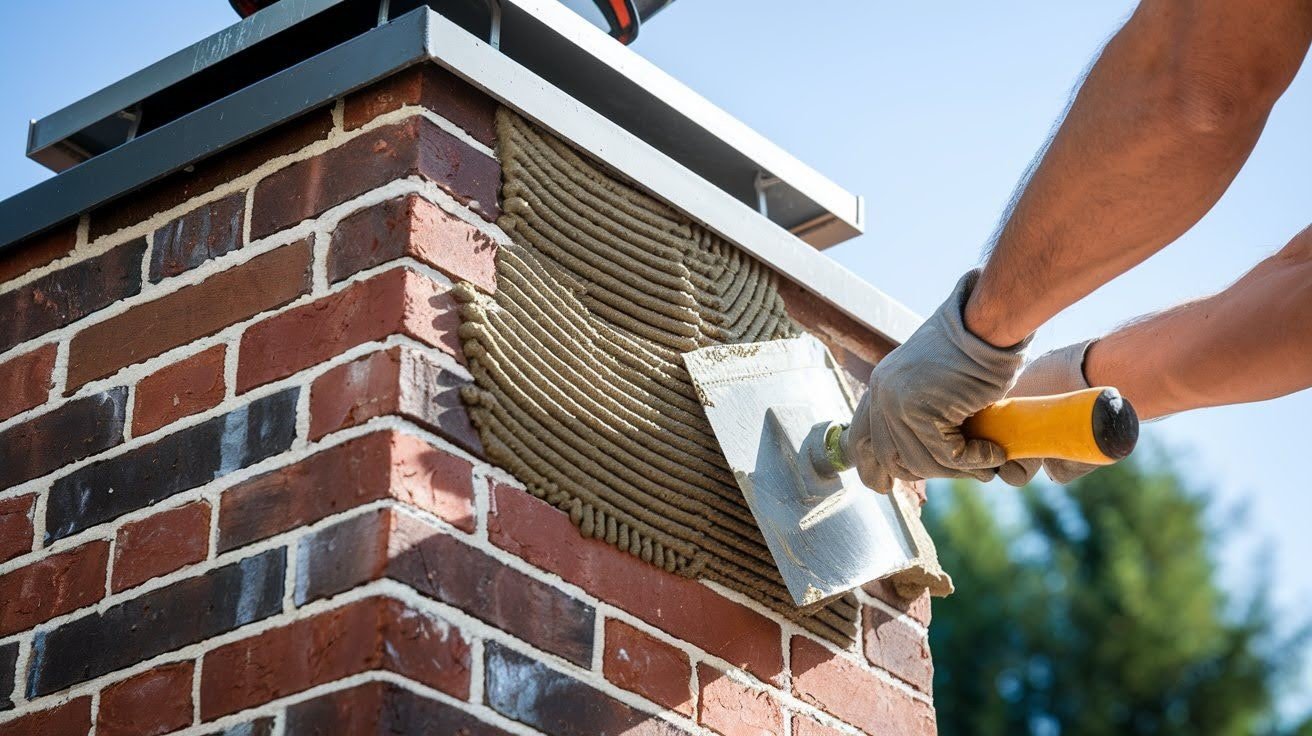
A repointed chimney is one where old, damaged mortar has been removed and replaced with fresh mortar. Think of it like dental work for your chimney. When a tooth has a cavity, the dentist removes the bad part and fills it with new material. Repointing does the same thing for chimney mortar.
The process involves:
- Scraping out old, weak mortar
- Cleaning the joints thoroughly
- Mixing new mortar to match the original
- Carefully filling each joint
- Smoothing and finishing the surface
This isn’t just cosmetic work. It’s structural repair that keeps your chimney standing strong.
Top Signs Your Chimney Needs Repointing
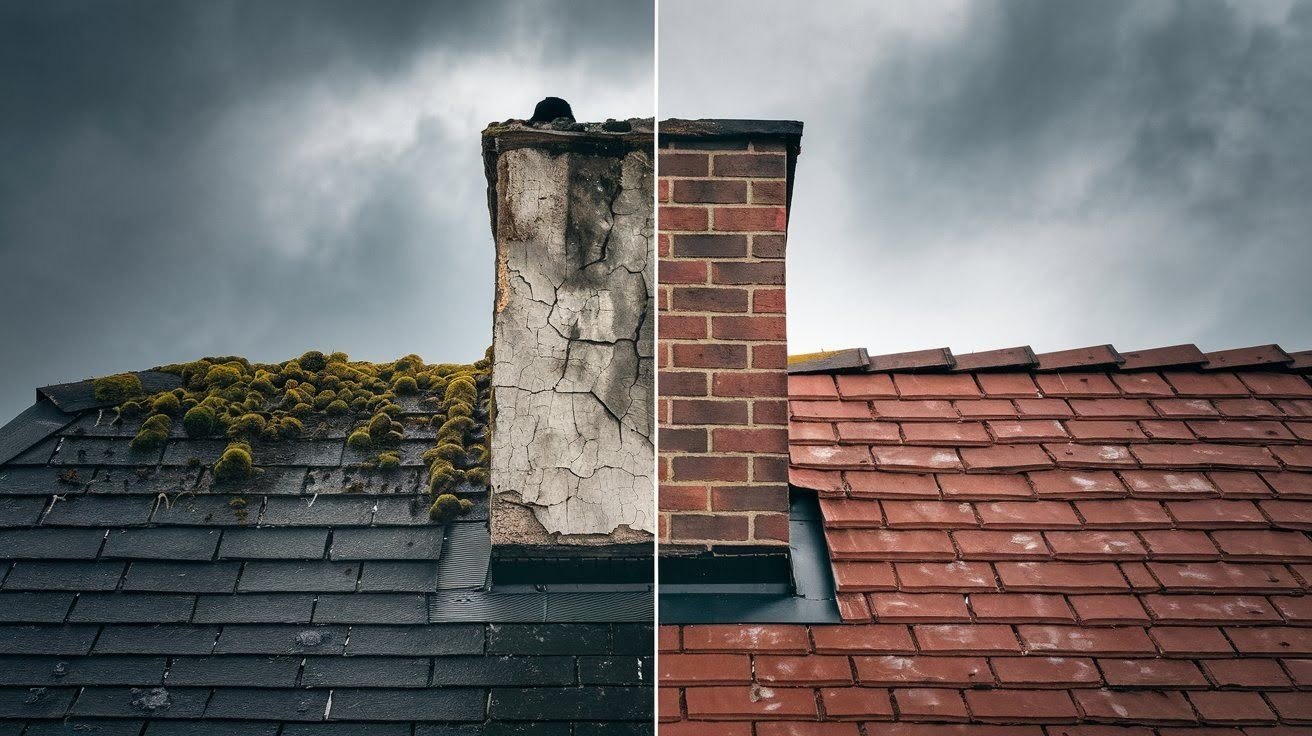
How do you know when your chimney needs help?
Look for these warning signs:
Cracked or crumbling mortar joints: The most obvious sign. If mortar is falling out when you touch it, you’ve got a problem.
White staining on bricks: Called efflorescence, this happens when water seeps through damaged mortar and leaves salt deposits behind.
Loose or wobbly bricks: When mortar fails, bricks lose their support. They may shift or feel loose to the touch.
Water damage inside your home: Leaks around the fireplace or chimney area often trace back to failed mortar joints.
Vegetation growing from joints: Plants love to grow in cracks where moisture collects. Not a good sign for your chimney.
Mortar dust on the ground: Check around your chimney’s base. Piles of sandy material mean mortar is breaking down.
But here’s what most homeowners miss:
Age alone isn’t always the deciding factor. A 20-year-old chimney in a harsh climate might need repointing before a 40-year-old chimney in mild weather.
Why Chimney Repointing Matters (and the Risks of Ignoring It)
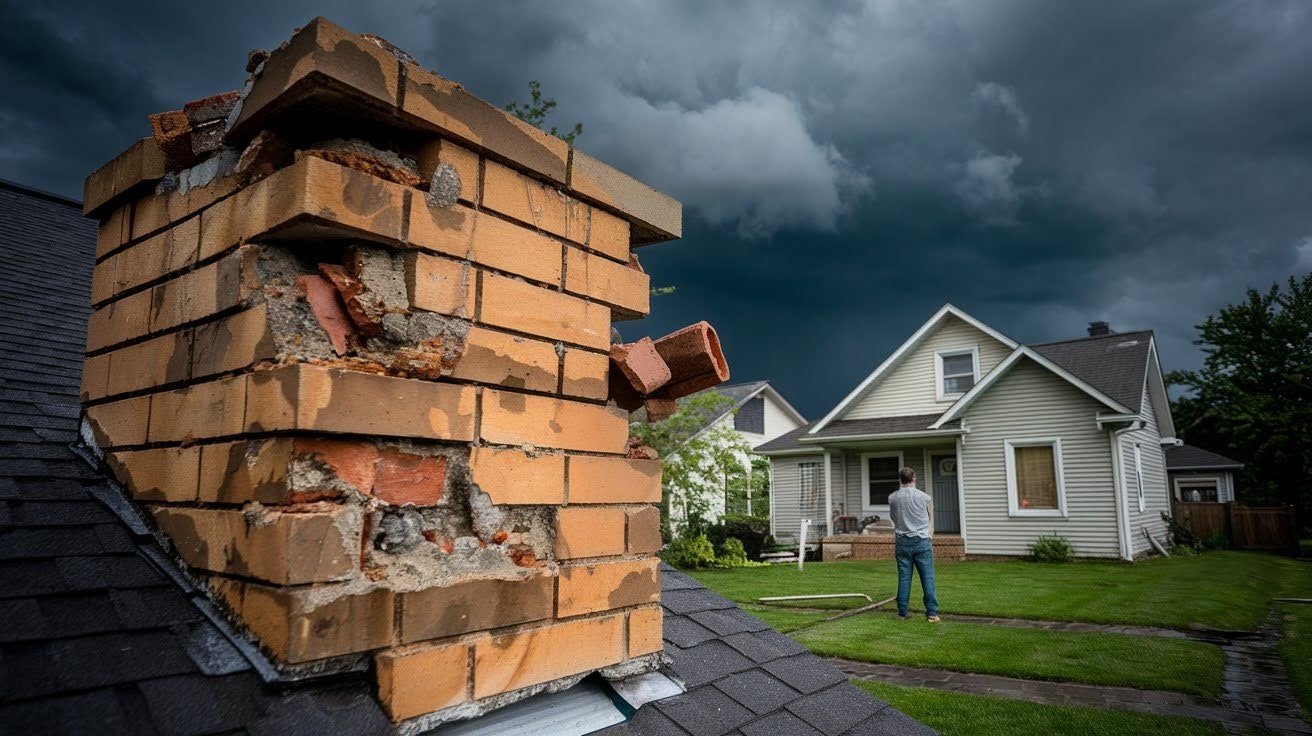
Ignoring damaged mortar isn’t just about looks. It’s about safety and money.
Water damage tops the list of concerns. Failed mortar lets water into your chimney structure. That water freezes and expands in winter, creating bigger cracks. The cycle repeats until major damage occurs.
Structural problems come next. Mortar holds your chimney together. Without it, bricks can shift or fall. I’ve seen chimneys collapse because owners waited too long. Higher repair costs hurt your wallet. A simple repointing job might cost $1,500. But if you wait until the chimney needs rebuilding? You’re looking at $10,000 or more.
Fire hazards develop when mortar gaps let heat escape into wood materials inside your walls. Pest problems arise when gaps give animals and insects easy entry points into your home.
The point is this: Early repointing saves money and prevents disasters.
How Is a Chimney Repointed? (Step-by-Step Overview)
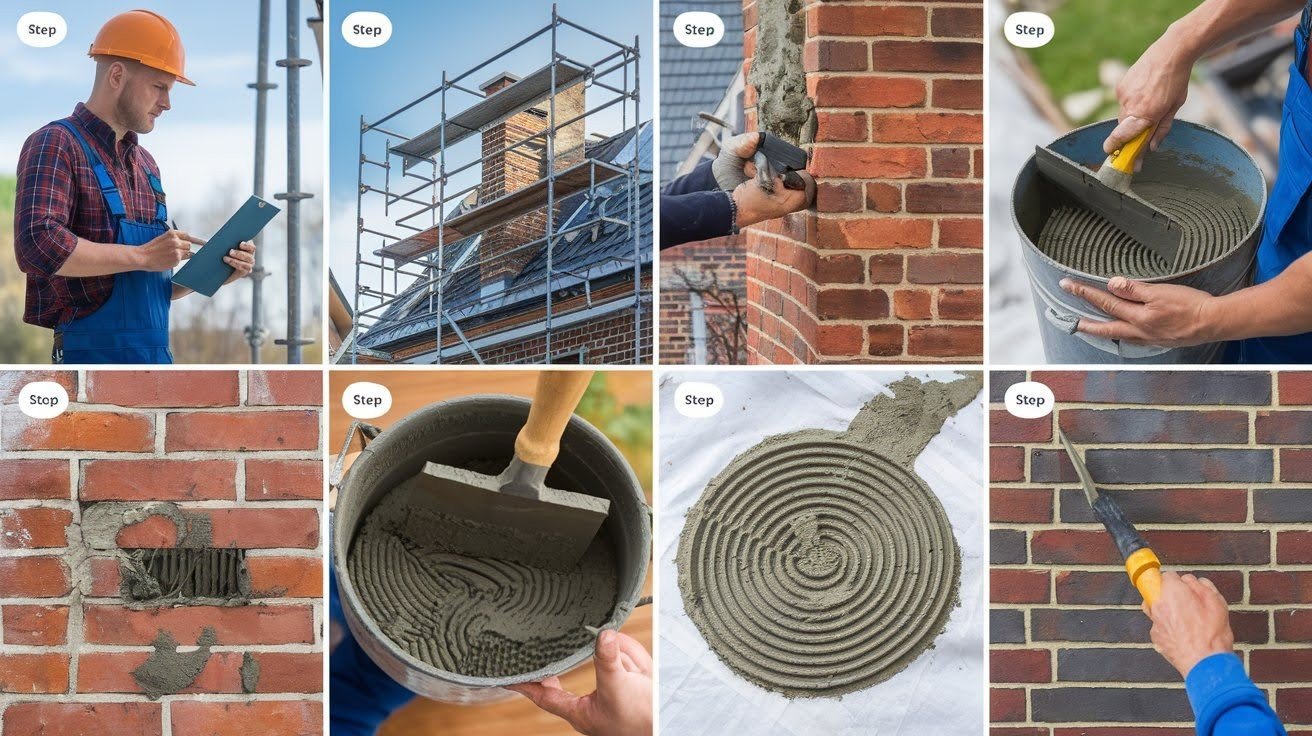
Professional repointing follows a careful process. Here’s what happens:
Step 1: Inspection and Assessment
The contractor examines your entire chimney. They check mortar condition, brick stability, and overall structure. This determines how much work you need.
Step 2: Setup and Safety
Scaffolding goes up around your chimney. Tarps protect your roof and landscaping. Safety equipment gets checked and double-checked.
Step 3: Mortar Removal
This is the messy part. Old mortar gets chiseled, ground, or cut out of the joints. The goal is removing all loose material without damaging the bricks.
Depth matters here. Contractors typically remove mortar to a depth of 2-3 times the joint width.
Step 4: Cleaning
All loose debris and dust must be removed. Clean joints are essential for proper bonding of new mortar.
Step 5: Mortar Mixing
New mortar gets mixed to match the original in color and strength. This isn’t guesswork – it requires skill and experience.
Step 6: Repointing
Fresh mortar is pressed into the clean joints using special tools. Each joint must be completely filled with no air pockets.
Step 7: Finishing
The mortar surface gets shaped and smoothed to match the original joint profile. This step affects both appearance and water shedding.
Step 8: Cleanup and Curing
The work area gets cleaned up. New mortar needs time to cure properly – usually several days to a week.
Total time: Most residential chimneys take 2-4 days to repoint, depending on size and damage extent.
Cost of Getting a Chimney Repointed
Repointing costs vary based on several factors:
Average price range: $1,500 to $4,000 for a typical residential chimney.
What affects the cost:
- Chimney height: Taller chimneys cost more due to additional scaffolding and safety requirements
- Damage extent: More damaged mortar means more work and higher costs
- Accessibility: Hard-to-reach chimneys require more complex setup
- Mortar type: Special mortars cost more than standard varieties
- Local labor rates: Costs vary by geographic area
Breakdown by chimney size:
- Small chimney (under 8 feet): $1,200-$2,500
- Medium chimney (8-15 feet): $2,000-$3,500
- Large chimney (over 15 feet): $3,000-$5,000+
Additional costs to consider:
- Scaffolding rental (if not included): $200-$500
- Permits (some areas require them): $50-$200
- Chimney cap replacement: $150-$400
Remember this: Cheap isn’t always better. Poor workmanship can cause bigger problems later. I always recommend getting at least three quotes from licensed contractors.
When’s the Best Time to Repoint Your Chimney?
Timing matters for chimney repointing. Weather plays a huge role in success.
Best seasons:
- Late spring (May-June)
- Early fall (September-October)
Why these times work:
- Mild temperatures help mortar cure properly
- Lower humidity prevents drying problems
- Reduced chance of rain during the work
- Contractors have better availability
Avoid these times:
- Winter: Cold temperatures prevent proper mortar curing
- Mid-summer: Extreme heat can cause mortar to dry too quickly
- Rainy seasons: Wet conditions ruin fresh mortar
Emergency situations are different. If your chimney has severe damage or safety concerns, don’t wait for perfect weather. A good contractor can work around weather challenges when necessary.
Plan ahead. Good repointing contractors book up during peak seasons. Start looking for quotes 2-3 months before you want the work done.
Choosing the Right Contractor for Chimney Repointing
Not all contractors are equal when it comes to repointing. This specialized work requires specific skills.
Required qualifications:
- Licensed and insured: Essential for any contractor
- Chimney-specific experience: General masonry isn’t the same as chimney work
- References from recent jobs: Ask to see before/after photos
- Written warranties: Good contractors stand behind their work
Red flags to avoid:
- Door-to-door sales pitches
- Prices significantly below other quotes
- Pressure to sign immediately
- No local references
- Cash-only payment requests
Questions to ask potential contractors:
- How many chimneys have you repointed in the last year?
- What type of mortar will you use?
- How do you match the original mortar color?
- What’s included in your warranty?
- Can I see photos of recent repointing work?
Get everything in writing. The contract should specify materials, timeline, cleanup procedures, and total cost. Check credentials with your state licensing board and Better Business Bureau.
Before & After: Real-World Results from a Repointed Chimney
Let me share what proper repointing accomplishes.
Before repointing, chimneys typically show mortar joints that are cracked and crumbling. You’ll often see white staining called efflorescence on brick surfaces where water has seeped through damaged mortar.
Water leaks during heavy rain are common, and bricks near the top may feel loose or wobbly. The overall appearance looks shabby and neglected.
After professional repointing, the same chimney has clean, uniform mortar joints that match the original color and texture. A waterproof seal protects against moisture, structural stability gets restored, and curb appeal improves significantly.
The change goes beyond looks. Homeowners tell me they no longer have water leaks, their heating efficiency has improved, they have peace of mind about safety, and their property value has increased.
Real example: A client’s 25-year-old chimney had severe mortar damage from freeze-thaw cycles. Water was leaking into their living room during storms. After repointing, the leaks stopped completely. The chimney looked like new, and they avoided a $15,000 rebuild.
Long-term benefits include:
- 15-20 years of protection before next repointing
- Prevented structural damage
- Maintained home value
- Avoided emergency repairs
The Point About Chimney Repointing
Your chimney’s mortar won’t last forever. When it starts failing, repointing becomes essential maintenance, not optional repair.
Key takeaways:
- Watch for early warning signs like cracked mortar and water damage
- Don’t delay – small problems become expensive disasters
- Choose experienced contractors with proper credentials
- Plan the work during favorable weather conditions
- Expect to invest $1,500-$4,000 for professional repointing
Most importantly: Repointing isn’t a DIY project. The skills, tools, and safety equipment required make professional service the smart choice. When done right, a repointed chimney protects your home and family for decades. When done wrong, you’ll face bigger problems and higher costs.
Take action now if you’ve noticed any warning signs. Get quotes from qualified contractors and schedule the work before minor issues become major headaches.
Your chimney – and your wallet – will thank you.
Conclusion
You now have everything needed to make smart decisions about chimney repointing.
Remember the key points. Watch for cracked mortar and water stains. Don’t wait when problems appear. Get three quotes from licensed contractors. Plan work during mild weather. Expect to spend $1,500 to $4,000 for professional service.
This isn’t just about fixing mortar. You’re protecting your home’s structure and your family’s safety. You’re also avoiding expensive emergency repairs down the road. The choice is yours. Act early and save money. Wait too long and face bigger problems. I’ve seen both outcomes many times.
Start today by inspecting your chimney for warning signs. Your future self will appreciate the smart decision you make right now.
Frequently Asked Questions
How long does repointed chimney mortar last?
Professional repointing typically lasts 15 to 20 years with proper maintenance. The lifespan depends on weather conditions, mortar quality, and installation workmanship.
Can I repoint my chimney myself?
DIY repointing is not recommended for safety and quality reasons. Professional contractors have the right tools, materials, and expertise to ensure lasting results.
What happens if I don’t repoint my damaged chimney?
Water will penetrate deeper into the structure, causing brick damage and potential collapse. Repair costs can increase from $2,000 to over $15,000 if you wait too long.
How do I know if my chimney needs full rebuilding instead of repointing?
If more than 25% of bricks are damaged or the chimney leans noticeably, rebuilding may be necessary. A professional inspection will determine the extent of damage and best solution.
Does repointing a chimney increase home value?
Yes, proper repointing can add $3,000 to $5,000 in home value while preventing costly structural damage. It also improves curb appeal and buyer confidence during home sales.


